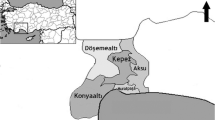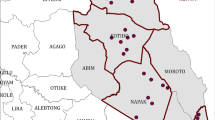Abstract
A cross-sectional study was conducted to determine the species composition and prevalence of ixodid ticks infesting horses in three agroecological zones in central Ethiopia. For this purpose, a total of 1,168 horses were examined for tick infestation. An overall prevalence of 39.04% of tick infestation on horses was recorded. A total of 917 adult ticks were collected from infested horses. Amblyomma, Boophilus, Rhipicephalus, and Hyalomma genera with the respective prevalence of 3.2%, 1.8%, 29.2%, and 4.7% were identified. In the study, Rhipicephalus evertsi evertsi was encountered with the highest prevalence (15.8%) whereas Amblyomma gemma was with lowest prevalence (1.5%). From the highland, Hyalomma marginatum rufipes (3.1%), Hyalomma truncatum (1.0%), and Boophilus decoloratus (0.3%) were identified. From the midland, R. evertsi evertsi (27.5%), Rhipicephalus pulchellus (18%), Amblyomma variegatum (3.6%), B. decoloratus (2.8%), H. marginatum rufipes (2.6%), H. truncatum (1.8%), and A. gemma (1.5%) were identified. R. evertsi evertsi, 107 (27.5%), was with the highest prevalence in the midland. From the lowland, R. pulchellus (22.3%), R. evertsi evertsi (20%), H. truncatum (3.6%), A. gemma (3.1%), B. decoloratus (2.3%), H. marginatum rufipes (2.1%), and A. variegatum (1.5%) were identified. In the lowland, R. pulchellus, 87 (22.3%), was the most abundant tick species. The overall prevalence of tick infestation on horses was significantly (P < 0.05) higher both in the midland, 225 (57.8%), and the lowland, 214 (54.87%), than the highland, 17 (4.4%). This suggests that horses in midland and lowland are at higher risk of tick infestation than those horses in the highland. Further studies on the role of ticks in transmission of diseases to equines and the importance of horses as alternative hosts in different parts of Ethiopia are needed.
Similar content being viewed by others
References
Abebayehu, T. and Kibrom, M., 2010. Study on ectoparasitic defects of processed skins at Sheba tannery, Tigray, northern Ethiopia, Tropical Animal Health and Production, 42, 1719–1722.
Abera, M., Mohammaed, T., Abebe, R., Aragaw, K. and Bekele, J., 2010. Survey of ixodid ticks in domestic ruminants in Bedelle district, south western Ethiopia, Tropical Animal Health and Production, 42, 1677–1683.
Bekele, T., 2002. Studies on seasonal dynamics of ticks of Ogaden cattle and individual variation in resistance to ticks in eastern Ethiopia, Journal of Veterinary Medicine B, 49, 285–288.
Chanie, M., Negash, T. and Sirak, A., 2010. Ectoparasites are the major causes of various types of skin lesions in small ruminants in Ethiopia, Tropical Animal Health and Production, 42, 1103–1109.
CSA., 2008. Ethiopian Agricultural sample Enumeration, 2001/2001 Central Statistics Authority, Federal Democratic republic of Ethiopia.
De Castro, J., 1997. Sustainable tick and tick-borne disease control in livestock improvement in developing countries, Veterinary Parasitology, 71, 77–97.
Dioli, M., Jean-Baptiste, S. and Fox, M., 2001. Ticks (Acari: Ixodidae) of the one-humped camel (Camelus dromedarius) in Kenya and southern Ethiopia: species composition, attachment sites, sex ratio and seasonal incidence, Revue d’Elevage et de Médecine vétérinaire des Pays tropicaux, 54(2), 115–122.
Ferede, B., Kumsa, B., Bsrat, A. and Kalayou. S., 2010. Ticks of donkeys in central Oromia regional state, Ethiopia, Revue de Médecine Vétérinaire, 161, 121–126.
G/Michael, T., 1993. Tick and tick-borne disease in North Omo Zone, DVM thesis, AAU, FVM, Debre Zeit, pp. 1–50.
Jongejan, F. and Uilenberg, G., 2004. The global importance of ticks, Parasitology, 129, S3–S14.
Labruna, M.B., Kerber, C.E., Ferreira, F., Faccini, J.LH., De Waal, D.T. and Gennari, S.M., 2001. Risk factors for tick infestations and their occurrence on horses in the state of São Paulo, Brazil, Veterinary Parasitology, 97, 1–14.
Labruna, M.B., Kasai, N., Ferreira, F., Faccini, J.LH. and Gennari, S.M., 2002. Seasonal dynamics of ticks (Acari: Ixodidae) on horses in the state of São Paulo, Brazil, Veterinary Parasitology, 105, 65–77.
Mekonnen, S., Hussein, I. and Bedane, B., 2001. The distribution of ixodid ticks (Acari: Ixodidae) in central Ethiopia, Onderstepoort Journal of Veterinary Research, 68, 243–251.
Mekonnen, S., Pegram, R.G., Gebre, S., Mekonnen, A., Jobre, Y. and Zewde, S., 2007. A synthesis of ixodid (Acari: Ixodidae) and argasid (Acari: Argasidae) ticks in Ethiopia and their possible roles in disease transmission, Ethiopian Veterinary Journal, 11(2), 1–17.
Mullugeta, Y., Yacob, H.T. and Ashenafi, H., 2010. Ectoparasites of small ruminants in three selected agroecological sites of Tigray region, Ethiopia, Tropical Animal Health and Production, 42, 1219–1224.
NMSA., 2004. National meteorological Service Agency, Addis Ababa, Ethiopia.
Pegram, R.G., Hoogstraal, H. and Wassef, H.Y., 1981. Ticks (Acari: Ixodoidea) of Ethiopia. Distribution, ecology and host relationship of species infesting livestock, Bulletin of Entomological Research, 71, 339–359.
Sertse, T. and Wossene, A., 2007. A study on ectoparasites of sheep and goats in eastern part of Amhara region, northeast Ethiopia, Small Ruminant Research, 69, 62–67.
Shannon, D., 1997. Dermatophilosis and abscessation of lymph nodes in a group of tick-infested horses in Uganda, Tropical Animal Health and Production, 29, 102–104.
SPANA, 2008. Society for protection of Animal Abroad .
Teglas, M., Matern, E., Lein, S., Foley, P., Mahan, S.M. and Foley, J., 2005. Ticks and tick-borne disease in Guatemalan cattle and horses, Veterinary Parasitology, 131, 119–127.
Thrusfield, M. (1995) Veterinary Epidemiology. 2nd ed. Blackwell Publishing, Oxford, pp. 339.
Walker, A.R., Bouattour, A., Camicas, J.L., Estrada-Pena, A., Horak, I.C., Latif, A.A., Pegram, R.G., and Preston, P.M., 2003. Tick of domestic animals in Africa: A guide to identification of species, Bioscience report, 42 Comiston Drive, Edinburgh EH10 5 QR Scotland, UK, pp. 3–210.
Wall, R. and Shearer, D., 1997. Veterinary Entomology, 1st Edition, Chapman and Hall, London, Pp1–438.
Wilson, R.T., 1995. The Tropical Agriculturalist. Livestock Production system, Distribution and Importance of Livestock in the tropics, 1sted. London, CTA Macmillan. Pp.5.
Yacob, H.T., Ataklty, H. and Kumsa, B., 2008a. Major ectoparasites of cattle in and around Mekelle, northern Ethiopia, Entomological Research, 38, 162–30.
Yacob, H.T., Nesanet, B. and Dinka, A., 2008b. Prevalence of major skin diseases in cattle, sheep and goats at Adama Veterinary Clinic, Oromia regional state, Ethiopia, Revue de Medecine Veterinaire, 159 (8–9), 455–461.
Zeleke, M. and Bekele, T., 2004. Species of ticks on camels and their seasonal population dynamics in eastern Ethiopia, Tropical Animal Health and Production, 36, 225–231.
Author information
Authors and Affiliations
Corresponding author
Rights and permissions
About this article
Cite this article
Kumsa, B., Tamrat, H., Tadesse, G. et al. Prevalence and species composition of ixodid ticks infesting horses in three agroecologies in central Oromia, Ethiopia. Trop Anim Health Prod 44, 119–124 (2012). https://doi.org/10.1007/s11250-011-9897-y
Accepted:
Published:
Issue Date:
DOI: https://doi.org/10.1007/s11250-011-9897-y




